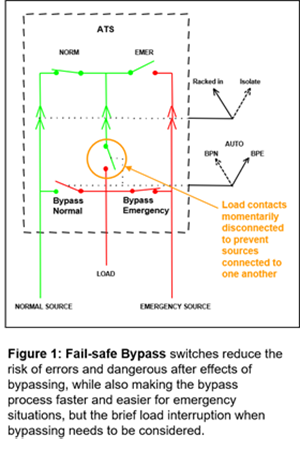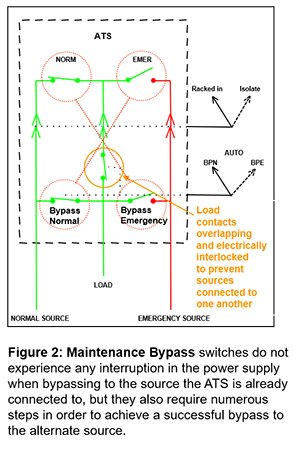Fail-safe versus maintenance bypass/isolation switches
This white paper explains the differences between fail-safe and maintenance bypass/isolation switches and reviews the advantages and disadvantages of each. The white paper deals only with the bypass function, which must not be confused with open- or closed-transition automatic or manual transfer switching.
Author: John Stark, Russelectric, A Siemens Business
Fail-safe bypass design
Fail-safe bypass/isolation switches provide an absolutely foolproof method of bypassing either the normal or the emergency power source around the automatic transfer switch (ATS) part of the unit to the load.
To achieve maximum operational flexibility, the fail-safe bypass design utilises an additional set of load contacts between the manual bypass switch section and the automatic transfer switch section, which allows the bypass switch handle to be thrown at any time—regardless of the position or condition of the transfer switch.
This extra set of load contacts in the bypass switch section momentarily isolates the load side of the ATS, allowing an operator to actuate the source bypass contacts with no thought whatsoever to the ATS. This is a tremendous benefit in an emergency situation where normal power has been lost and the ATS has failed to transfer.
After quickly checking to see that emergency power is available (automatic engine start would have been initiated upon failure of the normal source), the operator can simply throw the bypass handle to emergency, in one single motion.


Advantages
- Designed for rapid response in emergencies, the fail-safe bypass switch offers a fast, easy, totally mechanical, and absolutely foolproof method of bypassing the ATS, regardless of its condition or position, and allows an operator to restore power quickly to vital circuits in an emergency.
- The design is extremely simple and reliable. With its additional load contacts and foolproof mechanical interlocks, the fail-safe bypass switch design precludes the possibility of a direct short circuit that could bring down the entire power system.
- The fail-safe bypass switch’s foolproof mechanical interlock system is not dependent upon additional electrical interlocks, such as those required with maintenance bypass designs. Mechanical interlocks are engineered and purpose-built for extreme reliability. Their cam design, precision machining, and welding ensure long-term alignment and flawless operation without need for adjustment. Aircraft ball joints prevent interlock rods from binding.
- Fail-safe bypass switch contact mechanisms are identical to those used in the switch’s ATS section, simplifying maintenance and stocking of spare parts.
Disadvantage
- When a fail-safe bypass switch is bypassed, its load contacts will cause the same type of momentary load interruption that occurs when transferring a comparably sized transfer switch.
Maintenance bypass switch design
To bypass to either the normal or emergency source with a maintenance bypass switch, the ATS must be in the source position to which the operator wishes to bypass. If it is not, then it must be electrically or manually transferred to that source before it can be safely bypassed.
Some designs require feeder breakers to be opened first to accomplish the transfer. Or, the manual bypass switch must be bypassed to whatever source position the ATS is in, the ATS must be isolated, then the manual bypass switch must be bypassed a second time to the desired alternate source.
In an emergency situation, these additional steps can significantly increase the time required to bypass the ATS and restore power to the load. In addition, if the ATS portion of the unit has been damaged or intentionally locked in the opposite position, a manual transfer could be, at best, extremely hazardous or, at worst, impossible.
In this situation, operating the bypass switch could trigger an extended electrical outage (ironically, a situation it was designed to prevent) and/or present a serious safety hazard to personnel.
Advantage
- Allows bypass of the ATS section from either normal source to load or emergency source to load without load interruption, but only if the ATS is connected to the source to which the operator wishes to bypass. Otherwise, the operator must first manually transfer the ATS to this source and experience a load interruption.
Disadvantages
- Designed primarily to allow maintenance without an interruption of load, maintenance bypass switches do not meet the specification requirement: “Bypass of load to either the normal or emergency power source with complete isolation of the automatic transfer switch shall be possible regardless of the position or condition of the automatic transfer switch”.
- If for some reason the automatic transfer switch portion of the unit has been rendered mechanically or electrically inoperable while in the opposite position, bypass becomes impossible and the bypass/isolation switch is left useless. It is also important to consider that, in accordance with UL l008, manual operation of the automatic transfer switch is hazardous unless the manual operating handle of the transfer switch is external to the enclosure (a feature not typically specified).
- To prevent the possibility of a direct short circuit (by inadvertently connecting both sources together), the operation of most maintenance bypass switches is inhibited by an elaborate arrangement of electrical and mechanical interlocks that prevents the operator from bypassing a source to load while the transfer switch is in the alternate source (see Figure 2). The more elaborate these safeguards, the greater the possibility of malfunction or operator error.
Conclusion
With its additional (break-before-make) load contacts, the fail-safe bypass switch design reduces the number of steps and, therefore, the time required to bypass the ATS. This design allows the bypass switch to be thrown at any time, regardless of the position or condition of the ATS, dramatically simplifying the switch’s operation in emergencies and virtually eliminating the chance of operator error.
Fail-safe bypass switches should be considered when simple, fast and foolproof bypassing is needed for emergency outage situations and is the overriding concern.
Maintenance bypass switches should be considered when maintenance is the overriding concern.
Both types are advantageous in different use cases. When designing or updating a power control system, it is very important to choose the ATS/bypass switch type best suited to the particular use case.










